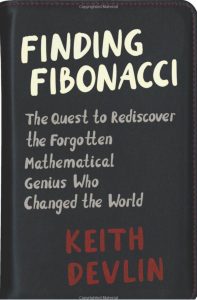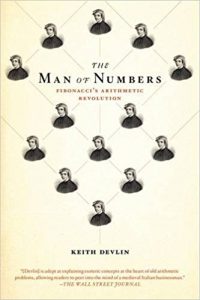Keith Devlin, well-known mathematician and author, has published two books on Leonardo Pisano (Leonardo of Pisa), better known to many today as “Fibonacci,” short for “filius Bonacci” (son of the Bonacci family), a name ascribed to Leonardo by the 19th century French historian Guillaume Libri. Devlin argues that Leonardo deserves to be ranked among the all-time most influential scientists and mathematicians, mainly for his key role in popularizing the Hindu-Arabic decimal system to Western Europe during the early Renaissance.

 Devlin’s books are:
Devlin’s books are:
- The Man of Numbers: Fibonacci’s Arithmetic Revolution
- Finding Fibonacci: The Quest to Rediscover the Forgotten Mathematical Genius Who Changed the World
Leonardo was hardly the first to discover decimal arithmetic. That honor goes to still-unknown mathematicians in India, at least by the year 300 CE and most likely earlier. One key source on the Indian origin of decimal arithmetic is the Bakhshali manuscript, an ancient mathematical treatise found in 1881 in the village of Bakhshali, Pakistan. The document presents numerous sophisticated mathematical methods, all illustrated with extensive decimal arithmetic calculations. Until recently, the consensus of scholars who had studied the manuscript was that it was written in either the 7th or the 12th century, but recent radiocarbon dating tests conducted by the Bodelian Library in London, where the document has been kept, show that at least part of it dates to as early as 300 CE. This confirms that mathematicians in India were well familiar with decimal arithmetic at least by this date and probably earlier. See our previous blog for details.
The Indian system was further developed by Islamic scholars in the Arab world, in the 9th, 10th, 11th and 12th centuries. One of these was Muḥammad ibn Mūsā al-Khwārizmī (whose surname is the origin of the English word “algorithm”), 780-850 CE. He developed sophisticated techniques to solve equations, and is thought to be the founder of algebra. Another prominent Eastern mathematician during this period was Omar Khayyam, 1048-1131 CE, today better known for his poetry.
Leonardo’s works
Leonardo Pisano was born in roughly the year 1175 in Pisa, Italy, the son of a wealthy merchant. His father directed a trading post in Bugia (now Bejaia) in Algeria, and took his son with him on at least one visit. It was in Bugia where Leonardo learned about Hindu-Arabic decimal arithmetic, having observed first-hand how the system was being used by traders and merchants there.
When he returned to Pisa, Leonardo vowed to bring these mathematical tools to a wider European audience. So in 1202 he wrote the book Liber Abbaci (“Book of Calculation”), a 600-page Latin treatise packed with hundreds of detailed problems and solutions, and then promoted it to the Italian scholarly community. He subsequently wrote additional works, including Practice Geometriae (a compendium of applications in practical geometry) and Liber Quadratorum (a compendium of techniques for solving Diophantine equations).
Of particular interest to modern readers was Leonardo’s treatment of topics in business and finance. Among other things, Leonardo introduced the technique of what we now call “present value analysis.” Additional details are given in Devlin’s books.
Sadly, not much is known about Leonardo’s personal life beyond these few facts. The last mention of his name during his lifetime was a note dated 1240 in the records of the Republic of Pisa, which recognized Leonardo for the services that he had given to the city. Thereafter he was largely forgotten to history for several centuries. From 1240 until the 19th century, the only mention of his name was in Summa de arithmetica geometria proportioni et proportionalità (“All That Is Known About Arithmetic, Geometry, Proportions, and Proportionality”), dated 1494, where the author Luca Pacioli concluded by writing, “Since we follow for the most part Leonardo Pisano, I intend to clarify now that any enunciation mentioned with the name of the author is to be attributed to Leonardo.” In 1838, the French historian Guillaume Libri read this note and vowed to learn more about this Leonardo Pisano, and it is largely through Libri that the modern world has learned about him.
Leonardo’s simplified book
One puzzle has long remained, however: None of the hundreds books and tutorials on decimal arithmetic that proliferated in the century or two after 1202 followed Leonardo’s Liber Abbaci very closely. This fact has led Keith Devlin and other scholars to conclude that Leonardo must have written some other book, a simplified version of Liber Abbaci written in vernacular Italian, that was the source for these subsequent works.
In fact, Leonardo himself mentioned an additional work, now lost, named Liber minors guise or Libro di merchaanti detto diminor guisa (“Book in a lesser manner or book for merchants”). But no such manuscript has ever been found.
A breakthrough occurred in 2003, when Italian scholar Rafaella Franci published her analysis of a remarkable manuscript she found in the Biblioteca Riccardiana in Florence. The manuscript is anonymous, but some details in the manuscript suggest that it was written in 1290 or so. Its author began by declaring “This is the book of abacus according to the opinion of master Leonardo of the house of sons of Bonacie from Pisa”. Roughly 3/4 of the problems presented in the book are Italian translations of problems from Chapters 8 through 11 in Liber Abbaci. Leonardo’s famous rabbit problem, which leads to the Fibonacci sequence, is included here, although recast in terms of pigeons.
The author of this manuscript did not appear to be a highly skilled mathematician, given some errors and other problems. It appears that for the most part he merely copied the entire book from some other work with at most minor changes. From her analysis, Franci concluded that this other work must have been Leonardo’s lost Libro di merchaanti detto diminor guisa. In other words, the anonymous manuscript is very likely a copy (but not a very good copy) of Leonardo’s original simplified book.
Finding Fibonacci
In his book Finding Fibonacci, Devlin recounted his personal decades-long search for Leonardo. Eventually Devlin was rewarded by personally handling two of the handful of existing original copies of Liber Abbaci, as well as the manuscript, mentioned above, that is now thought to be copied from Leonardo’s simplified work for merchants and traders. Devlin describes his experience at finally seeing the simplified manuscript in person in these terms: “See Florence and die, the saying goes. Well, I had just seen something that, for me, had an impact far exceeding anything to be found on the streets outside.”
What if Leonardo had lived earlier?
There can be no doubt that Leonardo’s writings were pivotal in the explosion of intercultural exchanges, trading and scientific advancements that happened in the the 13th, 14th and 15th century, which period of time we denote the Renaissance. We can only wonder how history would have changed if Fibonacci had lived earlier.
Suppose, for instance, that Fibonacci (and the Indian mathematicians that preceded him) had lived 1000 years earlier. Would the resulting infusion of decimal computation have rejuvenated European trade, science and technology, possibly reversing its decline and fall during the dark ages?
Suppose further that Fibonacci had been contemporary with Archimedes. What might have happened if Archimedes’ mathematical brilliance (he grasped and applied the basics of integral calculus 1800 years before Newton and Leibniz) had been combined with Hindu-Arabic decimal arithmetic? Our modern technological age might have been accelerated by nearly 2000 years. History would have been different, to say the least.